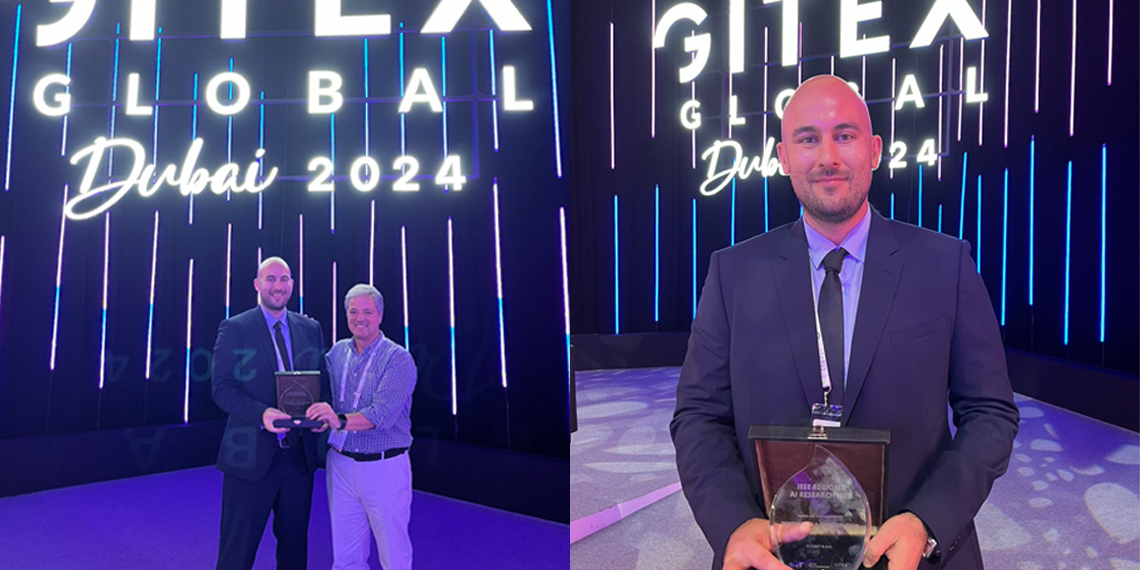Tamás Karácsony, a researcher at INESC TEC, received the award for Innovation in Artificial Intelligence (AI) at the IEEE AI Research Hub competition – organised by IEEE Entrepreneurship and the IEEE Region 8 Entrepreneurship Committee -; the event took place in Dubai, within the scope of GITEX Global 2024. Considered the largest technology and start-up fair in the world, GITEX Global 2024 featured a presentation by Tamás Karácsony about his research to classify epileptic seizures filmed with AI-powered 3D video technology. This pioneering work carried out at INESC TEC reinforces the role that the Institute has played in the connection between AI and health.
Epilepsy is a chronic neurological disease that affects about 1% of the world population and is drug-resistant in 30% of cases. Hence, there’s a great need to thoroughly evaluate the cases that present this resistance and that are candidates for neurosurgery. In this sense, doctors resort to different types of diagnostic tests, with the video electroencephalogram being the most decisive since the uncoordinated movement patterns induced by epileptic seizures are the main source of clinical information for diagnosis and therapeutic decision-making. However, this diagnosis is typically made through simple qualitative observation by trained physicians, but subject to inter-observer subjectivity and variability.
The INESC TEC researcher’s – also a PhD student on the Doctoral Programme in Electrical and Computer Engineering at the Faculty of Engineering of the University of Porto (FEUP) and in the CMU Portugal programme – proposal focuses on this video monitoring process using 3D images, using AI to detect and classify the semiology of seizures in the epilepsy monitoring units (and not through EEG). This analysis allows to understand relevant movement patterns, i.e., to automatically detect and characterise small sequences of movements during seizures that indicate the location of the origin in the brain – fundamental information for the therapeutic decision-making process regarding these cases. This approach leads to more accurate and quantitative monitoring of patients than simple visual monitoring, providing higher quality to the clinical decision-making process by medical teams. This new technique, which has now been awarded at GITEX Global 2024, will allow not only an optimisation in the monitoring of patients in neurology units, but also improve the results of treatments applied to said patients, e.g., neurosurgery.
“This research stems from my PhD thesis, supervised by João Paulo Cunha (INESC TEC/FEUP) and Fernando de La Torre (CMU) – which aims to classify epileptic seizures through an approach based on explainable deep learning, with 3D clinical movements’ capture. It’s a breakthrough innovation in biomedical engineering with great clinical potential, especially in the diagnosis and treatment of refractory epilepsy,” explained Tamás Karácsony.
To test the feasibility of this scientific solution, the researchers carried out a clinical study with 26 patients and two different types of epilepsy (frontal and temporal), as well as with population that did not suffer from the disease. The study relied on data from two institutions with whom INESC TEC has a long record of collaboration: the Centro Hospitalar Universitário de São João (Porto) and the Ludwing Maximilian University of Munich (Germany). In this 3D video database, they managed to collect a total of 115 seizures, which is the largest database of including this type of data to date. These results were published in an open-access article in the journal Nature/Scientific Reports.
“In the future, we would like to take this research to another level, with the recognition of actions based on AI-powered automatic extraction of skeletons, using 4K videos – because we consider that there are a number of associated benefits, like greater preservation of data privacy when we talk about collaboration with several hospitals, a more efficient use of rare clinical data, greater explainability of results, and faster and cheaper processes. These translate into better results for patients”, explained the INESC TEC researcher. This statement is based on a series of new scientific advances that were published by this multidisciplinary and international team this year, in the journal “Image and Vision Computing” – thanks to the work “Deep learning methods for single camera based clinical in-bed movement action recognition”.
The competition, which took place on October 18 at the Dubai World Trade Center, selected the top five submissions from several global applicants. The INESC TEC researcher was invited to present his work at the AI Main Stage before a panel of experts composed of renowned figures in the field of AI, like Stephen Ibaraki (founder of UN ITU AI for Good) and Chris Duffey (futurist at Adobe).
The researchers mentioned in this news piece are associated with INESC TEC and UP-FEUP.



 News, current topics, curiosities and so much more about INESC TEC and its community!
News, current topics, curiosities and so much more about INESC TEC and its community!